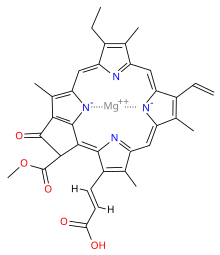Chlorophyll c refers to forms of chlorophyll found in certain marine algae, including the photosynthetic Chromista (e.g. diatoms and brown algae) and dinoflagellates.[1][2][3] These pigments are characterized by their unusual chemical structure, with a porphyrin as opposed to the chlorin (which has a reduced ring D) as the core; they also do not have an isoprenoid tail. Both these features stand out from the other chlorophylls commonly found in algae and plants.[2]
It has a blue-green color and is an accessory pigment, particularly significant in its absorption of light in the 447–520 nm wavelength region.[3] Like chlorophyll a and chlorophyll b, it helps the organism gather light and passes a quanta of excitation energy through the light harvesting antennae to the photosynthetic reaction centre.[2]
Chlorophyll c can be further divided into chlorophyll c1, chlorophyll c2,[3] and chlorophyll c3,[4] plus at least eight other more recently found subtypes.[5]
Chlorophyll c1 is a common form of chlorophyll c. It differs from chlorophyll c2 in its C8 group, having an ethyl group instead of vinyl group (C-C single bond instead of C=C double bond).
Its absorption maxima are around 444, 577, 626 nm and 447, 579, 629 nm in diethyl ether and acetone respectively.[6]
Chlorophyll c2 is the most common form of chlorophyll c.[7]
Its absorption maxima are around 447, 580, 627 nm and 450, 581, 629 nm in diethyl ether and acetone respectively.[6]
Chlorophyll c3 is a form of chlorophyll c found in microalga Emiliania huxleyi, identified in 1989.[4]
Its absorption maxima are around 452, 585, 625 nm and 452, 585, 627 nm in diethyl ether and acetone respectively.[6]
Chlorophyll c synthesis branches off early from the typical Chlorophyllide synthesis pathway, after divinylprotochlorophyllide (DV-PChlide) is formed. DV-PChlide can be processed directly by an unidentified 171 oxidase into Chl c2. An 8-vinyl reductase (elaborating on the promiscuous behavior of ferredoxin-type 3,8-divinyl chlorophyllide reductase) could then convert Chl c2 into Chl c1. The two steps could be swapped for the same effect.[8]
The 171 oxidtion appears to proceed by "hydroxylation of the 17-propionate reside at the 171-position and successive dehydration to the 17-acrylate residue."[9]
More information c1, c2 ...
| Chlorophyll c1 |
Chlorophyll c2 |
Chlorophyll c3 |
 |
 |
| Names |
| IUPAC name
[(2E)-3-[14-Ethyl-21-(methoxycarbonyl)-4,8,13,18-tetramethyl-20-oxo-9-vinyl-3,4-didehydro-3-phorbinyl-κ2N23,N25]acrylato(2-)]magnesium |
| Identifiers |
|
|
|
|
|
5801077, 6996880 |
| ChEBI |
|
| ChemSpider |
|
|
|
| UNII |
|
InChI=1S/C35H32N4O5.Mg/c1-8-19-15(3)22-12-24-17(5)21(10-11-28(40)41)32(38-24)30-31(35(43)44-7)34(42)29-18(6)25(39-33(29)30)14-27-20(9-2)16(4)23(37-27)13-26(19)36-22;/h8,10-14,31H,1,9H2,2-7H3,(H3,36,37,38,39,40,41,42);/q;+2/p-2/b11-10+,22-12-,23-13-,24-12-,25-14-,26-13-,27-14-,32-30-; Key: DGNIJJSSARBJSH-QRKQXEOSSA-L
|
CCC1=C(C)/C2=C/c3c(C=C)c(C)c4\C=C5/N=C(C(\C=C\C(O)=O)=C/5C)C5=c6c(C(=O)C5C(=O)OC)c(C)c(=CC1=N\2)n6[Mg]n34 c1: COC(=O)C9C(=O)c6c(C)c3n7c6c9c2c(C=CC(=O)O)c(C)c1cc5n8c(cc4n([Mg]78n12)c(c=3)c(CC)c4c)c(C=C)c5C
|
| Properties |
|
C35H30MgN4O5 |
| Molar mass |
610.953 g·mol−1 |
Except where otherwise noted, data are given for materials in their standard state (at 25 °C [77 °F], 100 kPa). |
|
 |
 |
| Names |
| IUPAC name
[(2E)-3-[21-(Methoxycarbonyl)-4,8,13,18-tetramethyl-20-oxo-9,14-divinyl-3,4-didehydro-3-phorbinyl-κ2N23,N25]acrylato(2-)]magnesium |
| Identifiers |
|
|
|
|
|
5801049 6996841 |
| ChEBI |
|
| ChemSpider |
|
|
|
| UNII |
|
InChI=1S/C35H30N4O5.Mg/c1-8-19-15(3)22-12-24-17(5)21(10-11-28(40)41)32(38-24)30-31(35(43)44-7)34(42)29-18(6)25(39-33(29)30)14-27-20(9-2)16(4)23(37-27)13-26(19)36-22;/h8-14,31H,1-2H2,3-7H3,(H3,36,37,38,39,40,41,42);/q;+2/p-2/b11-10+,22-12?,23-13?,24-12?,25-14?,26-13?,27-14?,32-30?; Key: QDRBYWCRXZZVLY-JUQUGTHISA-L
|
CC1=C(C2=CC3=NC(=CC4=C(C5=C([N-]4)C(=C6C(=C(C(=N6)C=C1[N-]2)C)C=CC(=O)O)C(C5=O)C(=O)OC)C)C(=C3C)C=C)C=C.[Mg+2] COC(=O)C9C(=O)c6c(C)c3n7c6c9c2c(C=CC(=O)O)c(C)c1cc5n8c(cc4n([Mg]78n12)c(c=3)c(C=C)c4c)c(C=C)c5C
|
| Properties |
|
C35H28MgN4O5 |
| Molar mass |
608.937 g·mol−1 |
Except where otherwise noted, data are given for materials in their standard state (at 25 °C [77 °F], 100 kPa). |
|
 |
| Identifiers |
|
|
|
|
|
|
| UNII |
|
InChI=1S/C36H30N4O7.Mg/c1-8-18-15(3)21-12-22-16(4)20(10-11-27(41)42)32(39-22)30-31(36(45)47-7)34(43)28-17(5)23(40-33(28)30)13-25-19(9-2)29(35(44)46-6)26(38-25)14-24(18)37-21;/h8-14,31,38,43H,1-2H2,3-7H3,(H,41,42);/q;+2/p-2/b11-10+,21-12?,25-13?,26-14?,32-30?;/t31-;/m1./s1 Key: CWLZENTWIZFJMW-XUGDHDJXSA-L
|
CC1=C(C2=NC1=CC3=NC(=C4C(C(=C5C4=NC(=C5C)C=C6C(=C(C(=C2)N6)C(=O)OC)C=C)[O-])C(=O)OC)C(=C3C)C=CC(=O)[O-])C=C.[Mg+2]
|
| Properties |
|
C36H28MgN4O7 |
| Molar mass |
652.946 g·mol−1 |
Except where otherwise noted, data are given for materials in their standard state (at 25 °C [77 °F], 100 kPa). |
|
Close
Fookes CJ, Jeffrey SW (1989). "The structure of chlorophyll c3, a novel marine photosynthetic pigment". J. Chem. Soc., Chem. Commun. (23): 1827–28. doi:10.1039/C39890001827. Zapata M, Garrido JL, Jeffrey SW (2006). "Chlorophyll c Pigments: Current Status". Chlorophylls and Bacteriochlorophylls: Advances in Photosynthesis and Respiration. Advances in Photosynthesis and Respiration. 25: 39–53. doi:10.1007/1-4020-4516-6_3. ISBN 978-1-4020-4515-8. Ito, Hisashi; Tanaka, Ayumi (March 2014). "Evolution of a New Chlorophyll Metabolic Pathway Driven by the Dynamic Changes in Enzyme Promiscuous Activity". Plant and Cell Physiology. 55 (3): 593–603. doi:10.1093/pcp/pct203. hdl:2115/58225. PMID 24399236.




